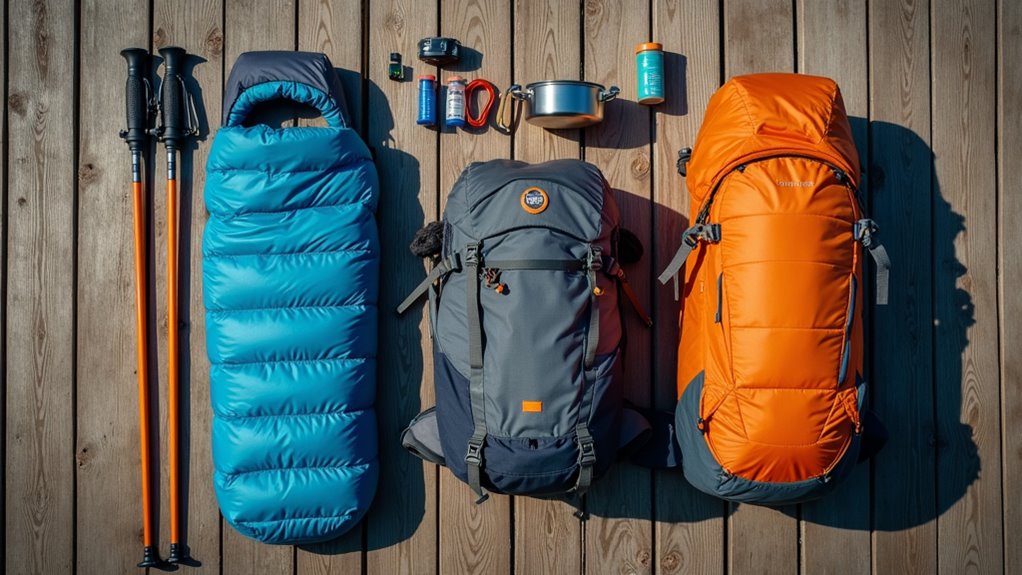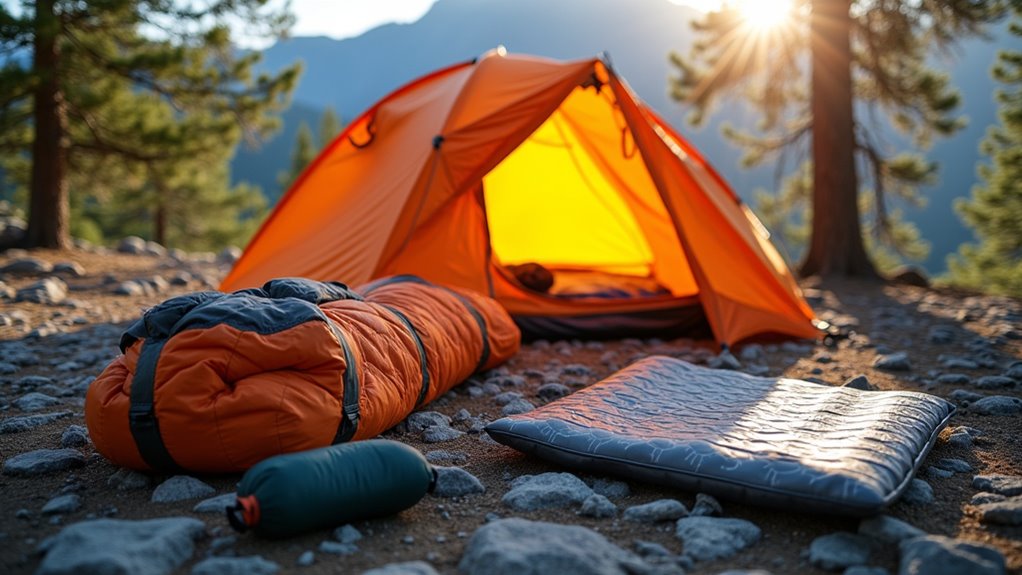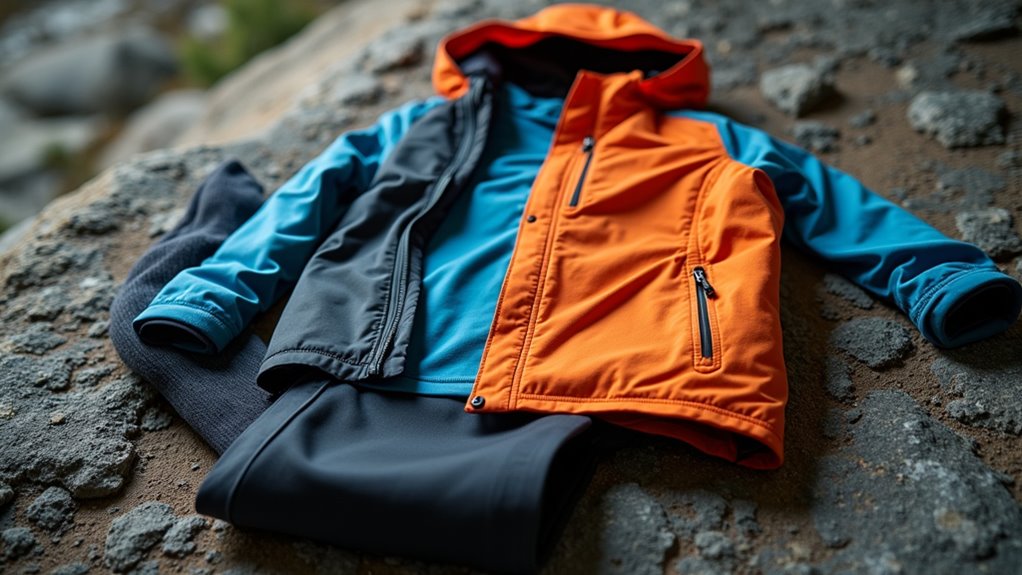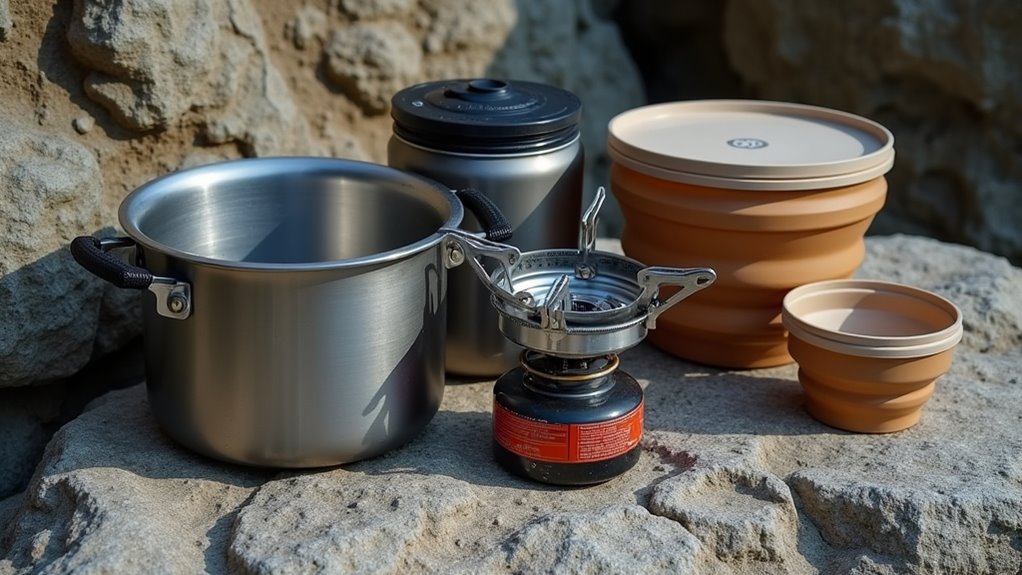Physical Address
304 North Cardinal St.
Dorchester Center, MA 02124
Physical Address
304 North Cardinal St.
Dorchester Center, MA 02124

Having the wrong backpacking gear can turn your dream adventure into a survival nightmare—discover the 8 essentials before you go.
You’ll spend roughly one-third of your backpacking trip inside your gear—sleeping, cooking, and seeking shelter from the elements. That’s why choosing the right equipment isn’t just about comfort; it’s about survival and staying within budget. Many beginners make costly mistakes by either overpacking unnecessary items or skimping on essentials that could save their lives. Before you hit the trail, there are eight critical categories of gear that’ll determine whether your adventure becomes an unforgettable journey or a nightmare you can’t escape.

When you’re miles from civilization with darkness approaching, your shelter and sleep system become the difference between a comfortable night and a miserable ordeal. Your tent should balance weight, durability, and weather protection. A three-season tent works for most conditions, while ultralight options save precious ounces.
Don’t skimp on your sleeping bag’s temperature rating—you’ll regret it at 3 AM when temperatures drop. Down insulation packs smaller but loses warmth when wet, while synthetic fill performs better in moisture.
A quality sleeping pad isn’t luxury—it’s essential insulation from cold ground that’ll steal your body heat. Choose between foam pads for durability or inflatable ones for comfort and packability.
For those early morning coffee rituals that fuel your hiking days, a portable espresso maker can deliver quality coffee even in remote locations without requiring lengthy preparation time.
Getting lost in the wilderness transforms a fun adventure into a life-threatening emergency, so you’ll need reliable navigation tools and safety gear that won’t break your budget. A detailed topographic map and compass are essential basics – they don’t need batteries and won’t fail when you need them most.
A topographic map and compass serve as your lifeline when technology fails and wilderness emergencies strike unexpectedly.
Download offline maps on your smartphone as backup navigation. Pack a loud whistle for emergencies, since three sharp blasts signal distress to rescuers.
A compact first aid kit should include bandages, pain relievers, and any personal medications. Don’t forget a headlamp with extra batteries for hands-free lighting.
A lightweight emergency shelter like a space blanket costs under five dollars but could save your life if weather turns dangerous unexpectedly. Whether you’re planning to rent or buy gear for your wilderness adventure, investing in quality navigation and safety equipment should always be your top priority.

Since weather conditions can change rapidly in the backcountry, you’ll want to master the art of layering rather than packing heavy, single-purpose garments.
The three-layer system works best for backpacking adventures:
You don’t need expensive gear to start. Budget-friendly synthetic options often outperform pricier alternatives.
Focus on fit and function over brand names, and you’ll stay comfortable without breaking the bank. Whether you’re planning a solo expedition or organizing a family camping trip, proper layering will keep everyone comfortable and safe in changing weather conditions.
How will you guarantee safe drinking water miles from the nearest tap? You’ll need reliable water treatment gear that won’t break your budget or your back.
Water filters are your first line of defense. Lightweight models like the Sawyer Mini or LifeStraw Personal remove bacteria and parasites for under $30.
Lightweight water filters under $30 provide essential bacteria and parasite protection without breaking your budget or weighing down your pack.
For more extensive protection, consider UV purifiers like the SteriPEN, which eliminates viruses too.
Don’t forget storage. Collapsible water bottles save pack space, while hydration bladders offer hands-free drinking on the trail. A 2-3 liter capacity typically suffices for day hikes.
Backup purification tablets cost pennies and weigh nothing—they’re perfect insurance. Always carry redundant treatment methods since equipment failures in the wilderness aren’t just inconvenient; they’re dangerous.
When canoeing and camping, having reliable water access becomes even more critical since you’ll be spending extended time on the water where resupply opportunities are limited.

Once you’ve secured your water source, you’ll need equipment to prepare hot meals and safely store your food. A lightweight stove system is essential for cooking in the wilderness, while proper food storage protects your supplies from wildlife and weather.
Your cooking and food storage essentials include:
For cold weather backpacking trips, consider bringing a camping heater to provide warmth during meal preparation and maintain comfortable temperatures inside your shelter.
While you’ve gathered your cooking gear and food storage solutions, none of it matters if you can’t carry it comfortably on the trail. Your backpack’s capacity should match your trip length—a 40-50 liter pack works for weekend trips, while week-long adventures need 60-70 liters.
A backpack that can’t carry your gear comfortably defeats the purpose of having quality equipment in the first place.
Don’t overspend on features you won’t use. Focus on proper fit first. The pack should sit snugly against your back with weight distributed to your hips, not shoulders. Look for padded shoulder straps, a supportive hip belt, and accessible pockets.
Consider buying used or last season’s models to save money. Test the pack with weight before purchasing—many outdoor stores let you load demo packs.
A well-fitted, moderately-priced pack beats an expensive one that doesn’t match your torso length. For extended adventures, ensure your pack has enough space and organization for creative backpacking food that will sustain you throughout longer journeys.

Even with the perfect pack on your back, wilderness emergencies can happen when you least expect them. That’s why you’ll need a well-stocked first aid kit that won’t break the bank or weigh you down.
Start with these essential supplies:
Don’t forget blister treatment supplies like moleskin – they’re lightweight and prevent minor foot problems from ruining your entire trip.
Keep everything organized in a waterproof pouch.
Whether you’re planning family camping activities or solo adventures, having proper emergency supplies ensures everyone can focus on enjoying the outdoors safely.
When you’re miles from civilization, every ounce in your pack needs to earn its place – and that’s where multi-purpose tools become your best friends. A quality multi-tool with pliers, knife, scissors, and screwdrivers handles countless trail repairs and camp tasks.
Don’t overlook duct tape – wrap some around your trekking poles to save space while gaining a universal fix-it solution.
Duct tape wrapped around trekking poles saves precious pack space while providing an instant repair solution for gear emergencies on the trail.
Paracord serves double duty as clothesline, gear tie-downs, and emergency rope.
A lightweight headlamp beats a flashlight since it keeps your hands free for cooking and setting up camp.
Pack a small carabiner or two for hanging food bags, securing gear, or quick equipment fixes.
If your backpacking adventure includes rock climbing, those carabiners become even more essential for anchoring and belaying systems.
Choose items that serve multiple functions, and you’ll lighten your load while staying prepared for whatever the trail throws at you.
You’ve spent months researching gear, comparing prices, and creating spreadsheets—only to discover you’ll probably forget half of it at home anyway. But here’s the thing: you don’t need every gadget on the market to have an incredible adventure. Start with the basics, buy what you can afford, and remember that the best backpacking stories often come from making do with less. Your wallet and your back will thank you later.